Tuesday
Mandala Projects, World, otherSurmang: Sing, my Sister, Sing!
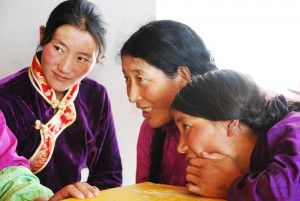 by Lee Weingrad of the Surmang Foundation. She speaks about the first Rural Health Festival that took place September 6th, 2011 at the Surmang Dharma Sagara Clinic in Tibet
by Lee Weingrad of the Surmang Foundation. She speaks about the first Rural Health Festival that took place September 6th, 2011 at the Surmang Dharma Sagara Clinic in Tibet
Copious juniper smoke billowed day-glo white, shifting in all directions. We were at 14,000 feet in Surmang. Children and dogs were running around. On the stage, with a hand to her ear, a nomad woman was singing a song that quickly jumped four octaves and pierced the rarefied air into the vastness. It was as though the same gusty wind snapping the prayer flags would carry her sound to the mountain tops. It got my attention. Like her song, the bejeweled Khampa Tibetan woman was at once majestic, playful, and threatening. When it was over, she took a second to collect herself and bring herself back to earth. She explained to me: “we offer our pure hearts through pure sounds as a prayer, an offering to the compassionate ones beyond space and time. Once they have heard my voice, they will give blessings to all the earth. The blessings of the silent world can travel to us by the sounds of our songs.”
At the same time, women’s laughter danced across the yard. On this particular day, the women were all dressed in red t-shirts that broadcast them as participants of the Surmang Foundation Rural Health Festival, kicking off the 5 day affair with entertainment and blessings.
The Back Story
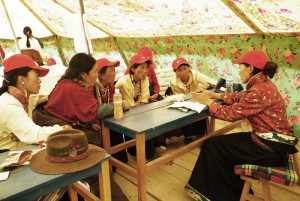 The event was modeled after “The Indonesian Rural Weaver’s Festival” run several years back by an NGO called Threads of Life. I first saw their video three years ago, when I stumbled upon Threads of Life’s magnificent store in Ubud, Bali. I wanted to do for rural health, women and children, what the Indonesian Festival did for weaving.
The event was modeled after “The Indonesian Rural Weaver’s Festival” run several years back by an NGO called Threads of Life. I first saw their video three years ago, when I stumbled upon Threads of Life’s magnificent store in Ubud, Bali. I wanted to do for rural health, women and children, what the Indonesian Festival did for weaving.
It was a long road to from concept to completion. It took an earth quake, a partnership with the Chinese Government, a robust Community Health Worker program, and most importantly the on-the-ground contribution of world-class rural health experts from around the globe. I had to wait 3 years until all the pieces were in place.
The realization of this idea was like many other Foundation ideas; it was the “Field of Dreams Model”: build the field and they will come. For years we had talked, speculated and dreamed about extending what we had accomplished at Surmang to other regions. We had worn out the idea of the region’s uniqueness, its Tibetan-ness and started to see this place as emblematic of a wider catchment of China’s ultra-poor nomads and farmers, whose most disturbing baggage was extreme maternal and infant mortality.
About two years ago, thanks largely to Ray Yip of the Gates Foundation and Peking University Institute of Population Studies, we actually started talking about the Surmang Model or Prototype, because we understood what we had done, its potential and where we wanted to go. The most important element is the buy-in from the local community we serve, especially women who mobilize their communities for public health. These are the 40 Surmang Community Health Workers, and since the inception, this program has heard their voice. These women are the arms and legs of our clinic. Without local indigenous buy-in we would be like a building without a foundation, no matter how inspired our vision.
But the question remained: How do we propel our project from a one-off, “stove-piped” project into something that could be sustainable, something that could work within the public health system?
The Support
It wasn’t until the disastrous 2010 Yushu earthquake that we had the answer to that question, when we had the opportunity to enlist the partnership of the government in rolling out this model in the shadow of the earthquake’s epicenter. In December of last year, we signed the game-changing agreement with the Chinese government to help restore the township health system through the adaptation of the Surmang model. Another 6 months would pass after that, because the Boston Consulting Group developed a plan for implementing the agreement. At the same time, Dr. Yip had fleshed out the way in which we could induce best practices in these township clinics by working with the reform measures found in the Rural China Medical Scheme.
But there was a gap in our planning: How to connect these remote farming and nomadic communities to their larger rural township clinic? The answer was by mobilizing these communities for public health in much the same way we’ve done it at Surmang: through Community Health Workers (CHWs) and a more vigorous township doctor program.
We had the commitment of 5 world-class rural public health experts: Dr. Amy Levi, Dr. Mariette Wiebenga, Dr. Mary Wellhoner, Karen Deutsch, and Dr. Dawn Factor. They agreed to come to Surmang for a Rural Health Festival, one that would put our CHWs in center stage, at a peer-led conference. The festival was designed to have these women share their different travel experiences, their village life, their major problems and their proposed solutions. And of course it also included bonfires, singing and dancing.
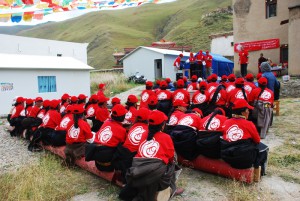 The Festival
The Festival
There were a lot of ways it could fail. We needed to put up and feed 60 people for 6 days in a remote corner of Eastern Tibet, meaning we needed beds and quilts. We needed to send out trucks to go get them. We had to build a team who felt part of the process. Nike gave us bright red shirts and baseball caps with the festival logo on them in Tibetan, Chinese and English. We had banners and prayer flags. We had tags with names of all the registrants. We had 4 trilingual Tibetans as coordinators and we even had a Chinese chef!
I was a little nervous the first day. Would this fly? Would they see it as a foreign expert affair? When would they start to take ownership of this process? The answer to the last question was: immediately. From the opening ribbon-cutting by the government to the departures on flatbed trucks and minibuses, everyone seemed so happy to just be there, to be together, with no responsibilities other than telling their story and expressing their hopes for the future.
The first day the CHWs gathered in groups and vividly told their travel stories and shared information about the places they came from. Two days later, they were discussing their biggest health problems. It was a defining moment for the festival: it looked like an ice flow had suddenly burst. Their animated discussions segued into skits they designed to role-play these problems.
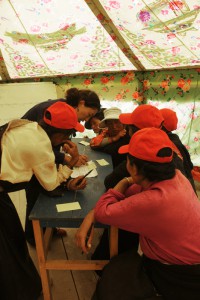 A few hours later the groups performed their skits. The action ranged from the dramatic to something resembling the Marx Brothers, and evoked 17th century Italian commedia dell’arte with its exaggerated movement. This all took place outside on temporary stages, using various props in place of extensive scenery. The action was full of colorful characters such as foolish old men, devious hospital administrators, or officials full of false bravado.
A few hours later the groups performed their skits. The action ranged from the dramatic to something resembling the Marx Brothers, and evoked 17th century Italian commedia dell’arte with its exaggerated movement. This all took place outside on temporary stages, using various props in place of extensive scenery. The action was full of colorful characters such as foolish old men, devious hospital administrators, or officials full of false bravado.
One poor, illiterate nomadic woman with a troubled pregnancy was told to fill out forms in Chinese, come back in the afternoon, and offer big deposits before they could be treated. Then someone tells her about a free clinic at Surmang. She goes there: no forms, no money and hey presto: in a few minutes of labor, she gives birth to a healthy, bouncing teddy bear!
Nights consisted of a final banquet and a bonfire circled by traditional Tibetan dance. They offered their own version of Annie Lennox’s anthem-like song “Sing”:
Sing, my sister… sing! Let your voice be heard. What won’t kill you will make you strong. Sing, my sister… sing!
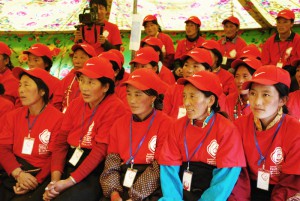 The last day consisted of the women creating an action plan for their next steps. Everyone agreed that our energy should be put into mobilizing communities for public health. It was agreed that the Surmang Foundation could strengthen the ties between nomads, farmers, men, women and public health knowledge. That we should build bridges between the community and the village clinics and township clinics. All of our public health experts agreed that this kind of bottom-up approach was the heart of any institutional reform we could offer.
The last day consisted of the women creating an action plan for their next steps. Everyone agreed that our energy should be put into mobilizing communities for public health. It was agreed that the Surmang Foundation could strengthen the ties between nomads, farmers, men, women and public health knowledge. That we should build bridges between the community and the village clinics and township clinics. All of our public health experts agreed that this kind of bottom-up approach was the heart of any institutional reform we could offer.
The last day witnessed an auspicious event – one of our CHWs gave birth to a baby girl! That was the event that “dotted the i’s and crossed the t’s” for us. As the last CHW departed, I looked at the remaining staff: “now we really have to go to work.”
~~
For more information on the Surmang Foundation, please visit their website: www.surmang.org

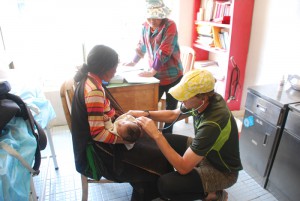




Nov 17, 2011
Reply
Thank you! A beautiful story!
Nov 17, 2011
Reply
Bravo! Bravo! Bravo! Such a touching report — thank you for such good work!
Nov 17, 2011
Reply
Lee,
Wonderful to see this story. Thanks for all your hard work. It’s great to hear about this project.
Cheers~
Kristi